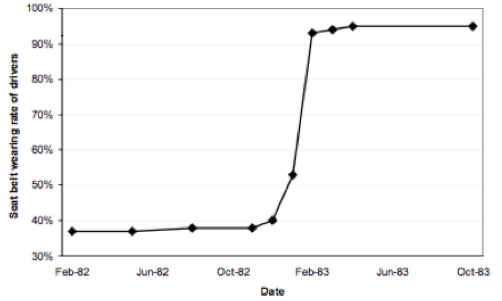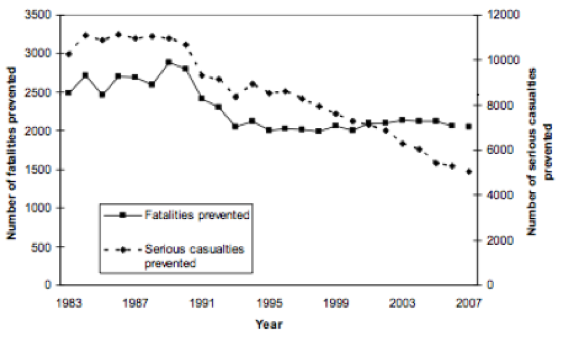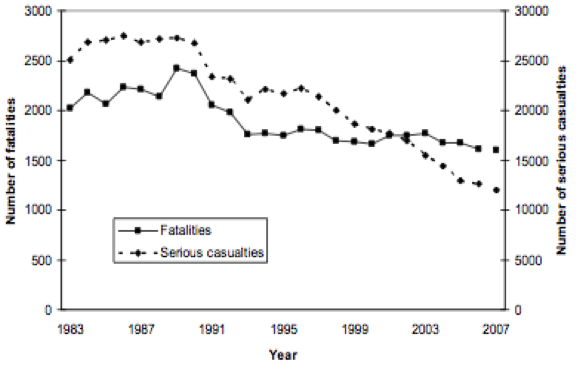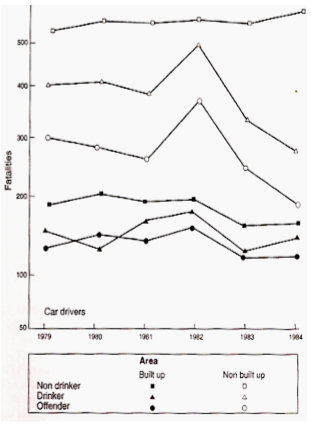To Robert Gifford
Executive Director, The Parliamentary Advisory Council for Transport Safety
Dear Rob
Thank you for sending me a paper claiming that seat belts have saved 57000 lives in the UK between 1983 and 2007. Is this the source of the 60000 claim posted on your website in 2008?
I have discovered that the paper you have sent me (by DC Richards, R Hutchins, RE Cookson, P Massie and RW Cuerden) is accessible on line at http://bast.opus.hbz-nrw.de/volltexte/2012/527/pdf/ .
The paper documents an increase in seat belt wearing rates for drivers of well over 100%. I have no reason to doubt the accuracy of the data represented in their Figure 6.
Figure 6. Effect of seat belt legislation on seat belt wearing rates for car drivers
It then estimates that seat belts are 61% effective in preventing fatalities in crashes. The fact that wearing a seat belt considerably improves ones chance of surviving a crash is also not disputed.
It then calculates (their Figure 5) how many lives have been saved by seat belts since the UK law came into effect.
Figure 5. Number of car occupant casualties prevented by seat belts
It also presents a graph showing how many fatalities remain. (their Figure 4)
Figure 4. Fatal and serious car occupant casualties
And herein lies a mystery.
Richards et al have charted a large increase in the use of a safety measure that provides significant protection in crashes. This measure they claim saved over 2500 lives a year (and rising!) in the first 8 years of the law. With such a sudden large increase in the adoption of such an effective safety measure one should see a large downward step in the established downward trend. Where is it? One cannot see any effect in the graphs here and here . Richards et al dont even look for it; their graphs dont start until 1983. They appear remarkably uncurious about why it should be that in the first eight years after the law the more lives seat belts were saving (Figure 5), the more car occupants were being killed (Figure 4). And they display no interest in the possibility of risk compensation: factors such as any change in driving behaviour for occupants who do / do not wear a seat belt were not taken into account (p 229).
Further they make no comment on the fact that the reduction in driver fatalities that did occur in 1983 (the year in which evidential breath testing was introduced) consisted almost entirely of drivers with alcohol in their blood.
Great Britain driver deaths by place and alcohol level in dead driver. Source: Broughton and Stark 1986
Three questions:
1.Do you consider that the paper by Richards et al validates the 60000 claim still on your website?
2.If so can you explain the absence of the large downward step that should appear in the graphs here and here ?
3.Can you explain why seat belts were so extraordinarily selective in saving the lives of drivers who had been drinking?
Finally you say:
I do not wish to be drawn into the debate about the benefits/disbenefits of cycle helmets. PACTS aim must be to improve the safety of all classes of road user and tackle the issue of the disproportionate risk placed upon those least able to protect themselves.
It was not my intention to draw you into a debate about the benefits/disbenefits of cycle helmets; the PACTS reporton this subject seems to me to be admirably clear and balanced. But I am interested in PACTS aspiration to tackle the issue of the disproportionate risk placed upon those least able to protect themselves.
I am seeking confirmation of a point I raised in my last open letter. From your Significance article it appears that it Is PACTS position that a measure that saves the lives of motorists is justified so long as the number of vulnerable road userskilled as a result is smaller. Is this your position?




